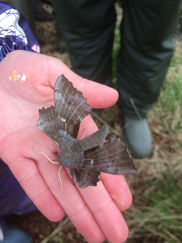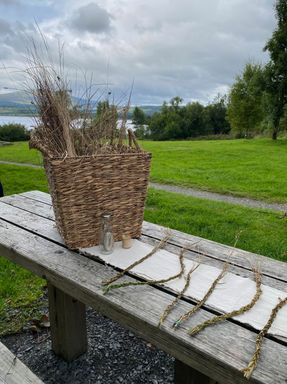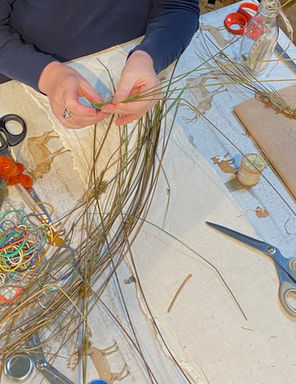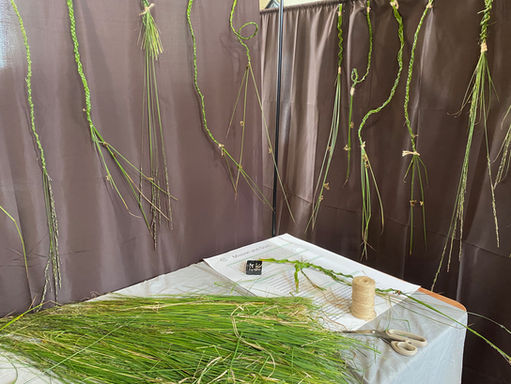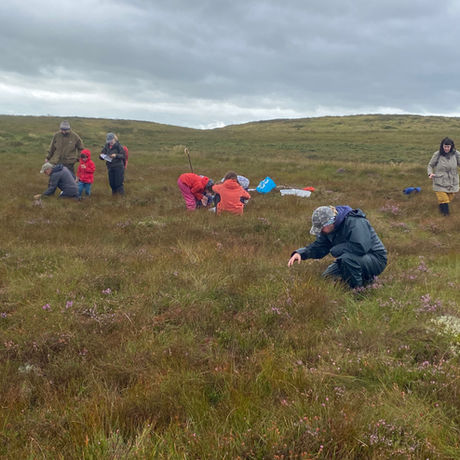Outreach and Collaboration
The outreach and collaboration strand of Peatland Connections delivered a series of one day, one off events, designed to introduce people to different ways of experiencing peatlands. In collaboration, the CCC team co-developed and delivered eight events, working with partners and environmental colleagues. The final event, The Bog Banquet, was a peatland celebration that brought art and ecology to the table in equal measures.
Discovering the beautiful and incredible moths at Knowetop Lochs Nature Reserve with moth expert Alison Robertson. May 2022
Following on from Marvellous Moths, an autumn visit to Knowetop Lochs Nature Reserve; this time with moth expert Alison Robertson and sound artist Lee Patterson who made audible hidden sounds emanating from to Knowetop Lochs’ more-than-human inhabitants.
Kick, Tag, and Probe
Kick Sampling along the Upper Urr, with Galloway Fisheries Trust, to investigate and determine Water Quality. This stretch of the Upper Urr is a site of community interest. In 2022, local residents founded the Upper Urr Environment Trust (UUET) to preserve, protect, and make publicly accessible this stretch of water and the adjoining peatland. Photos by Duncan Ireland.
Deep Peat Deep Time
Scottish Archaeology Fair, Castle Douglas, 2022, with Archaeology Scotland
Castle Douglas was once a peatbog. A pony cap, the Torrs Pony Cap, estimated dates back to 300–200BC, was excavated in 1812 when land was drained to develop the town. Peat preserves organic matter and holds a record of past time; the deeper the peat, the deeper in back in time it takes us. One metre of peat can take up to 1000 years to form. Going back so far in time is challenging for us to get our heads around. Using a 3m peat core taken from a glade in an afforested Galloway peatland, visitors to the Fair were invited to ‘flag’ dates of interest to them along the 3,000 year timeline of the peat core. We were able to tangibly navigate a journey back through time and into deep time and flag histories connected to Galloway, along with world history events. We reflected on how our histories have brought us to where we are; how the past connects us to the present; and how the past can inform and help us to take positive steps that will protect Galloway’s unique landscape for future generations.
As time passed at the Archaeology Fair, the sodden peat leached peat stained water out into the paper. As a collaborative act in response to the flow of water, we traced the water’s marks.
Sheep Wool Bunding
Stewartry Agricultural Show 2022, with Galloway Glens
In peatland restoration, to rewet a peatland, blocking drainage ditches is fundamental practice. Two widely used methods to dam and stop water draining off bogs are coir logs and wooden dams. Coir logs bend and can be manipulated to fit within drainage ditches, creating undulating dams. They look softer in the landscape and as they bio-degrade they become vegetated with mosses and upland grasses. Over time, they amalgamate into the restoring peatland. Coir is an imported natural material made from the husks of coconut. Looking closer to home, an alternative to coir logs could be sheep wool bunds. The use of sheep wool for peatland restoration has been trialled on a handful of sites in the UK. It is not common practice and sheep wool bunds are not commercially available. This means you must make your own. Curious to trial sheep wool bunds on a CCC restoration site, we set about making them at the Stewartry Agricultural Show, inviting people to join in.
Sheep wool is an abundant local product, the use of which would support local economies. However, if sheep have been treated with pyrethroid insecticide the sheep wool could be a potential source of water pollution. Before SEPA will grant permissions for the use of sheep wool bunds, pre-trial leaching tests on treated fleeces are requested to demonstrate their use would not pose any threat to the environment. For now, sheep wool bunding plans are on hold while we investigate further. Photos by Duncan Ireland.
Textiles Happening
With Textile Artist Morag Macpherson. Taking the process of creating garments inspired by peatland flora out into public places to generate conversations about peatlands and Morag’s Peatland Collection.
Creatures of the Deep Peat Bog
With Peatland Ecologist and Habitat Restoration Specialist Stephen Corcoran
Whether hidden from plain sight, discrete, or conspicuous, traces, signs, sightings and encounters, iridescent darts, scurrying, and chirrups alert us to the creatures of a bog and bring to light the rich tapestry of life interwoven into the fabric of a peatland. We expected to encounter birds and the insects, spiders, and bugs that they feed on. We hoped to discover signs and traces of mammals revealed though droppings (scats), nests and burrows. Reptiles, perhaps. We didn’t expect a downpour and weather warnings. We didn’t expect anyone to turn up. They did. All-but-one who had booked on came to explore the Upper Urr peatland in the wet. Not a lot of wildlife was spotted, except for the odd spider and quite a few slugs. None the less, a great day out sharing knowledge and stories and absorbing the joys of wet weather on a peatland.
Bog Banquet
Peatland Connections could not have evolved as it did without the generosity of our partners organisations, those who participated in events, and the artists, ecologists, and scientists we worked with.
To celebrate the wonder of peatlands, and to and thank those who shared their knowledge, creativity, and time, we created an immersive multi-sensory experience that brought together food, art, ecology, and people. Photos by Duncan Ireland.











